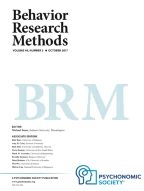Abstract
Event detection is used to classify recorded gaze points into periods of fixation, saccade, smooth pursuit, blink, and noise. Although there is an overall consensus that current algorithms for event detection have serious flaws and that a de facto standard for event detection does not exist, surprisingly little work has been done to remedy this problem. We suggest a new velocity-based algorithm that takes several of the previously known limitations into account. Most important, the new algorithm identifies so-called glissades, a wobbling movement at the end of many saccades, as a separate class of eye movements. Part of the solution involves designing an adaptive velocity threshold that makes the event detection less sensitive to variations in noise level and the algorithm settings-free for the user. We demonstrate the performance of the new algorithm on eye movements recorded during reading and scene perception and compare it with two of the most commonly used algorithms today. Results show that, unlike the currently used algorithms, fixations, saccades, and glissades are robustly identified by the new algorithm. Using this algorithm, we found that glissades occur in about half of the saccades, during both reading and scene perception, and that they have an average duration close to 24 msec. Due to the high prevalence and long durations of glissades, we argue that researchers must actively choose whether to assign the glissades to saccades or fixations; the choice affects dependent variables such as fixation and saccade duration significantly. Current algorithms do not offer this choice, and their assignments of each glissade are largely arbitrary.
Article PDF
Similar content being viewed by others
Avoid common mistakes on your manuscript.
References
Applied Sciences Laboratory (2001). Eyenal manual: Version 1.0 [Computer software manual]. Bedford, MA: Author.
Bahill, A. T., Brockenbrough, A., & Troost, B. T. (1981). Variability and development of a normative data base for saccadic eye movements. Investigative Ophthalmology & Visual Science, 21, 116–125.
Blignaut, P. (2009). Fixation identification: The optimum threshold for a dispersion algorithm. Attention, Perception, & Psychophysics, 71, 881–895.
Cuiffreda, K. J., & Tannen, B. (1995). Eye movements for the clinician. St. Louis: Mosby.
Deubel, H., & Bridgeman, B. (1995). Perceptual consequences of ocular lens overshoot during saccadic eye movements. Vision Research, 35, 2897–2902.
Duchowski, A. T. (2003). Eye tracking methodology: Theory and practice. New York: Springer.
Engbert, R., & Kliegl, R. (2003). Microsaccades uncover the orientation of covert attention. Vision Research, 43, 1035–1045.
Frens, M. A., & Van der Geest, J. N. (2002). Scleral search coils influence saccade dynamics. Journal of Neurophysiology, 88, 692–698.
Inchingolo, P., & Spanio, M. (1985). On the identification and analysis of saccadic eye movements—A quantitative study of the processing procedures. IEEE Transactions on Biomedical Engineering, 32, 683–695.
Irwin, D. E. (2004). Fixation location and fixation duration as indices of cognitive processing. In J. M. Henderson & F. Ferreira (Eds.), The interface of language, vision, and action: Eye movements and the visual world (pp. 105–133). New York: Psychology Press.
Kapoula, Z. A., Robinson, D. A., & Hain, T. C. (1986). Motion of the eye immediately after a saccade. Experimental Brain Research, 61, 386–394.
Karsh, R., & Breitenbach, F. W. (1983). Looking at looking: The amorphous fixation measure. In R. Groner, C. Menz, D. F. Fisher, & R. Monty (Eds.), Eye movements and psychological functions: International views (pp. 53–64). Hillsdale, NJ: Erlbaum.
Matin, E. (1974). Saccadic suppression: A review and an analysis. Psychological Bulletin, 81, 899–917.
McConkie, G. W., & Loschky, L. C. (2002). Perception onset time during fixations in free viewing. Behavior Research Methods, Instruments, & Computers, 34, 481–490.
Nyström, M., & Holmqvist, K. (2008). Semantic override of low-level features in image viewing—both initially and overall. Journal of Eye Movement Research, 2, 2:1–2:11.
Rayner, K. (1998). Eye movements in reading and information processing: 20 years of research. Psychological Bulletin, 124, 372–422.
Rottach, K. G., Das, V. E., Wohlgemuth, W., Zivotofsky, A. Z., & Leigh, R. J. (1998). Properties of horizontal saccades accompanied by blinks. Journal of Neurophysiology, 79, 2895–2902.
Rötting, M. (2001). Parametersystematik der augen- und blickbewegungen für arbeitswissenschaftliche untersuchungen. Aachen, Germany: Shaker.
Salvucci, D. D., & Goldberg, J. H. (2000). Identifying fixations and saccades in eye-tracking protocols. In Proceedings of the 2000 Symposium on Eye Tracking Research and Applications (pp. 71–78). New York: ACM Press.
Savitzky, A., & Golay, M. J. E. (1964). Smoothing and differentiation of data by simplified least squares procedures. Analytical Chemistry, 36, 1627–1639.
Shic, F., Chawarska, K., & Scassellati, B. (2008). The amorphous fixation measure revisited: With applications to autism. In B.C. Love, K. McRae, & V. M. Sloutsky (Eds.), Proceedings of the 30th Annual Meeting of the Cognitive Science Society (p. 1964). Austin, TX: Cognitive Science Society.
Shic, F., Scassellati, B., & Chawarska, K. (2008). The incomplete fixation measure. In Proceedings of the 2008 Symposium on Eye Tracking Research and Applications (pp. 111–114). New York: ACM Press.
Smeets, J. B. J., & Hooge, I. T. C. (2003). Nature of variability in saccades. Journal of Neurophysiology, 90, 12–20.
SR Research (2007). EyeLink user manual. Version 1.3.0 [Computer software manual]. Ottawa, ON: Author.
Stampe, D. M. (1993). Heuristic filtering and reliable calibration methods for video-based pupil-tracking systems. Behavior Research Methods, Instruments, & Computers, 25, 137–142.
Weber, R. B., & Daroff, R. B. (1972). Corrective movements following refixation saccades: Type and control system analysis. Vision Research, 12, 467–475.
Author information
Authors and Affiliations
Corresponding author
Additional information
Members of the eyetracking group at Lund University Humanities Lab are acknowledged for helping to record the data and commenting on earlier drafts of the manuscript.
Rights and permissions
About this article
Cite this article
Nyström, M., Holmqvist, K. An adaptive algorithm for fixation, saccade, and glissade detection in eyetracking data. Behavior Research Methods 42, 188–204 (2010). https://doi.org/10.3758/BRM.42.1.188
Received:
Accepted:
Issue Date:
DOI: https://doi.org/10.3758/BRM.42.1.188
